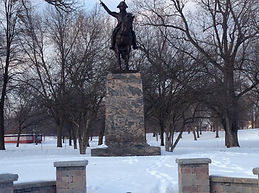
Tradition of Deceit
Chloe Ellefson Mystery #5
The book takes place in Milwaukee, WI and Minneapolis, MN during February 1983, with historical threads set in 1878 and the 1920s.
Curator and occasional sleuth Chloe Ellefson is off to Minneapolis to help her friend Ariel with a monumental task. They must write a proposal for a controversial and expensive restoration project to convert a huge abandoned flour mill—currently used as an unofficial shelter by homeless people—into a history museum.
When a dead body is found in the building, stuffed in a grain chute, Chloe reluctantly turns her attention from milling to murder.
Back in Milwaukee, Chloe's love interest Roelke McKenna has been slammed with the news that a fellow police officer (his best friend) has been shot and killed while on duty.
Sifting through clues from the past and present, Chloe and Roelke separately discover dangerous secrets that put their trust in each other—and their very lives—at risk.
Tradition of Deceit is readily available as a 360-page trade paperback and in ebook versions. Each contains photos and a cast of characters.
Places
Most of the scenes in this book are set at real places that still exist and can be visited (except for the private homes).
Below are custom interactive maps designed to enable you to virtually visit the key locations where the story takes place.
Related Blog Posts
Why the Mill City Museum?

In Tradition of Deceit, Chloe visits a friend in Minneapolis to help with a proposal to turn a long-abandoned flour mill into a museum. The mystery is set in 1983, when such discussions and plans were underway. The visionaries were ultimately successful, and the Minnesota Historical Society opened the Mill City Museum in 2003.
Tunnel of Fudge Cake

I had not heard of the Tunnel of Fudge Cake until I began doing research while writing Tradition of Deceit (the 5th Chloe Ellefson mystery), which celebrates Minnesota’s flour milling history and the Mill City Museum. As soon as I heard the name, I knew Chloe would love it. When I heard it was probably the most popular recipe in the history of Pillsbury’s famous Bake-Off, I knew I wanted to include it in the book.
Meet Pawel

Often in the Chloe books, a very minor character ends up being among the most memorable. I discovered this when The Heirloom Murders (the 2nd Chloe Ellefson Historic Sites mystery) was published. Many readers wrote to me about Johann and Frieda, even though the elderly couple were only briefly onstage.
Wycinanki

Folk art plays a role in most of the Chloe Ellefson mysteries. Since Tradition of Deceit features bits of Polish culture, I decided to include wycinanki—the Polish form of paper cutting.
Researching Tradition of Deceit

Mr. Ernst here. In Tradition Of Deceit (TOD) Chloe and Roelke get caught up in separate mysteries, in separate cities, each facing deadly perils on their own.
Hands-On Wycinanki

Readers have been wondering where they can try their hands at wycinanki, the art of Polish paper cutting featured in Tradition of Deceit. (Learn more about wycinanki here.) If you live in Wisconsin, try contacting the Polish Center of Wisconsin, the Polish Heritage Club of Madison, or other local Polish heritage groups. (Similar groups in other parts of the country can probably also provide information.) I’ve taken several workshops with Kasia Drake-Hames.
Urban Anthropology in Milwaukee’s Old South Side

I discovered the wonderful work being done by Urban Anthropology while working on Tradition of Deceit.
Polish Heritage

In previous Chloe books I’ve featured Norwegian, Swiss, and Danish culture. When I began conceptualizing Tradition of Deceit, the 5th Chloe Ellefson Historic Sites mystery, I knew I wanted to celebrate a different ethnic group. The first time I toured the Mill City Museum, where some of the book is set, the guide told us that the earliest women employees were hired during World War I. The company began packing flour into small five-pound sacks, and managers believed that women were best suited for that job.
Cooking With Betty Crocker

When I was writing Tradition of Deceit, I marveled at the connections between the the Mill City Museum, one of the settings, and popular American culture. The museum was created within what was once the Washburn-Crosby A Mill. You may not have heard of Washburn-Crosby, but chances are good you’ve heard of Gold Medal Flour.
Roelke Goes To Prison

When writing Tradition of Deceit, I needed to include a set scene at a prison. Waupun Correctional Institution was the logical choice. The prison is one of the oldest in the country. It is listed on the Wisconsin register of historic places, and in 1992 was added to the National Register of Historic Places as the “Wisconsin State Prison Historic District.”
Why Milwaukee’s Old South Side?

If you’ve read any of the Chloe Ellefson Historic Sites mysteries, you’ve already met Officer Roelke McKenna. Based on reader mail, he’s a popular guy. Well, in Tradition of Deceit, Roelke gets his fair share of page time.
Pączki – Polish Doughnuts

In Poland—and Polish communities—Fat Thursday is observed on the Thursday before Lent. People traditionally celebrate by eating pączki (pronounced POHNCH-kee), fried rounds of sweet yeast dough often filled with jelly. The doughnuts are eaten in such quantities that the day is called Pączki Day.
A Retrospective

As I began conceptualizing Tradition of Deceit, the 5th Chloe Ellefson Mystery, I had several goals in mind. Since main characters Chloe and Roelke were getting along pretty well by the end of the previous book, I figured it was time to throw a new challenge their way: distance.














